American pastry is a fascinating blend of various cultural influences, showcasing a rich tapestry of flavors, techniques, and innovations. This diversity stems from the country’s history of immigration, technological advancements, and regional adaptations. American pastry techniques have evolved significantly, reflecting the unique contributions of different communities and the continuous quest for culinary excellence.
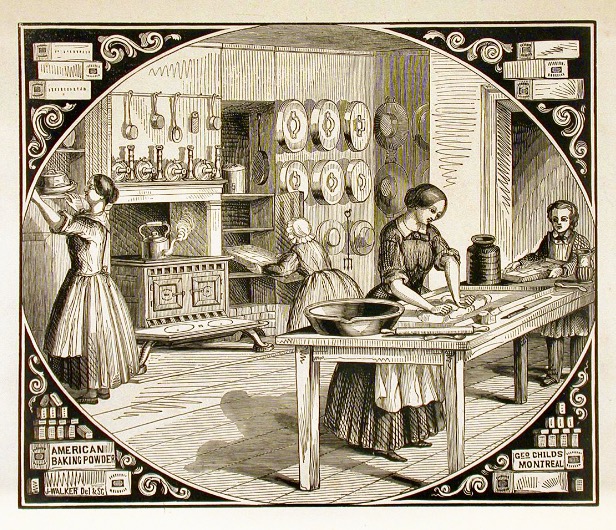
McCord Stewart Museum Montreal
Colonial Beginnings
Early Influences
The early American pastry scene was shaped predominantly by European settlers, particularly those from England, France, and the Netherlands. These settlers brought with them traditional baking techniques and recipes, laying the foundation for what would become American pastry.
English Influence
Pies, Tarts, and Puddings: English baking traditions heavily featured pies, tarts, and puddings, which were integral to daily meals and festive occasions alike in England. Pies, in particular, were a versatile dish, enjoyed both sweet and savory. In America, settlers continued this tradition, adapting recipes to incorporate local ingredients and regional tastes.
Apple Pie: One of the most iconic examples of adaptation is the apple pie. While apple pies were already popular in England, the varieties of apples available in America differed from those in Europe.

Wikipedia/Public Domain
The adaptation of apple pie in America is documented in various historical sources. For instance, in her book “American Cookery” published in 1796, Amelia Simmons provides one of the earliest known recipes for apple pie in America. Her recipe reflects the use of local ingredients and the adaptation of European baking techniques to the New World environment.
Custards and Creams: Another significant contribution of English baking traditions to early American pastry was the love for custards and cream-based desserts. Custards, typically made with eggs, milk, and sugar, were used in a variety of pies and tarts. Simple custard pies became a staple in American kitchens, offering a creamy and comforting dessert that appealed to both English settlers and their descendants.
French Influence
Pâté à Choux: One of the most enduring contributions of French settlers to American pastry is the technique for making pâté à choux, or choux pastry. This versatile dough is characterized by its unique method of cooking on the stovetop before being mixed with eggs to create a light, airy pastry. In America, this technique was adapted to create beloved pastries such as profiteroles (cream puffs) and éclairs, which became popular desserts across the country. The introduction of pâté à choux marked a shift towards more intricate and delicate pastry techniques in American baking.
Tarts and Flans: French settlers also brought with them the tradition of tarts and flans, which are characterized by their delicate pastry shells and rich, often creamy fillings. In America, bakers adapted French tart recipes to incorporate local fruits and ingredients, such as berries, apples, and citrus fruits. This adaptation allowed for the creation of seasonal pastries that showcased the abundance of North American produce while maintaining the French tradition of using high-quality pastry techniques.
The influence of French pastry techniques in North America is well-documented in culinary history and literature. French settlers, particularly in regions like Louisiana, where French culinary traditions melded with local Creole and Cajun influences, contributed to the development of a distinctive Southern pastry culture that incorporated French baking methods with local ingredients.
Dutch Influence
The Dutch settlers, particularly in New York (originally New Amsterdam), made significant contributions to American pastry with their hearty and straightforward baking style. Their culinary traditions, rooted in Northern European baking techniques, left a lasting impact on early American desserts, influencing the development of several iconic treats that are still enjoyed today.
Cookies (Koekjes): Dutch settlers introduced the concept of cookies to America, which initially were simple, spiced, or buttery treats. The Dutch word “koekjes” translates to “little cakes,” reflecting their small, cake-like nature. Over time, these early cookies evolved into a wide variety of forms and flavors, such as gingerbread, speculaas (spiced shortcrust biscuits), and butter cookies, which became staples in American baking and are enjoyed year-round.
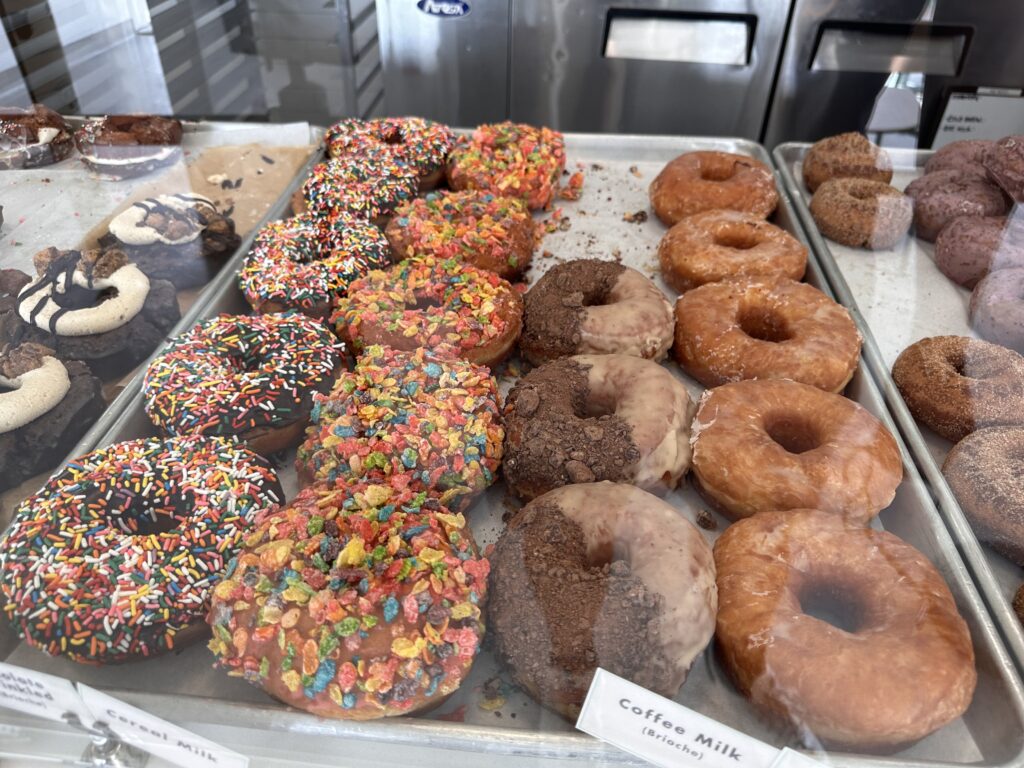
Doughnuts (Olykoeks): The Dutch brought with them recipes for fried doughnuts, known as “olykoeks” or “oily cakes.” These early doughnuts were small, fried balls of dough that were often flavored with nutmeg and other spices. The concept of frying dough in oil was adapted and refined by American bakers, leading to the development of the classic American doughnut. Over time, doughnuts became a popular treat enjoyed at breakfast, during coffee breaks, and at various social gatherings across the country.
“The first donut shop was founded by Anna Joralemon in New York City,” writes Helena Nichols, Mashed.com. “Joralemon set up shop on Maiden Lane off Broadway, where she sold ‘olykoeks,’ pronounced similarly to ‘oily cakes.’ This was in the days before the title ‘donut’ even existed.”

Apple and Cherry Pies: Dutch settlers were renowned for their skill in baking pies, particularly lattice-topped pies filled with apples, cherries, and other seasonal fruits. These pies became an integral part of American culinary tradition, appreciated for their robust flavors and comforting textures. The Dutch brought their expertise in pie-making to America, where the adaptation of local ingredients like apples and cherries flourished, leading to the widespread popularity of fruit pies in American households.
The Dutch influence on American pastry is well-documented in culinary history and literature, showcasing how early European settlers shaped the diverse and evolving landscape of American desserts. Their contributions not only enriched American baking traditions but also contributed to the cultural tapestry of the nation.
Ingredients and Techniques
Adaptation to Local Ingredients
European settlers arriving in the Americas encountered a bounty of new ingredients that would profoundly influence their culinary traditions. Adapting their traditional recipes to incorporate these novel ingredients gave rise to a rich tapestry of distinctly American pastries.
Adaptation of Traditional Recipes:
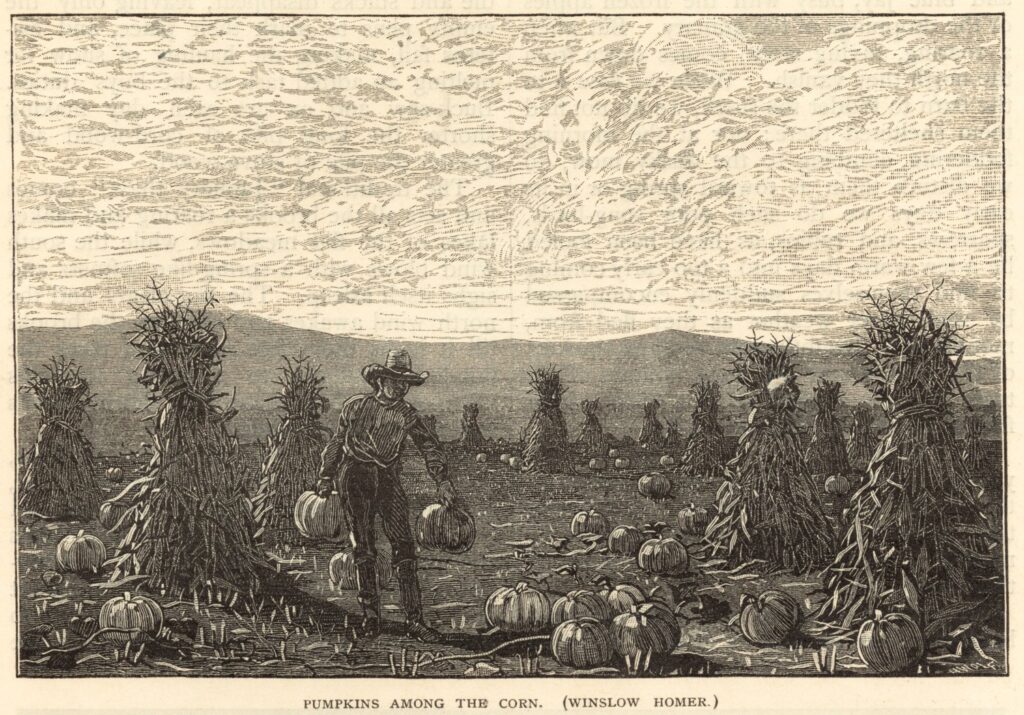
Pumpkin: When European settlers arrived in North America, they encountered an abundance of pumpkins, a versatile native plant that had long been cultivated and utilized by Native Americans in their diet. Recognizing its suitability for their culinary needs, settlers swiftly embraced pumpkins as a staple due to their plentiful supply and long storage life.
This newfound availability of pumpkins prompted settlers to adapt traditional European pie recipes to incorporate pumpkin as a filling. One of the earliest recorded American pumpkin pie recipes is found in “American Cookery” by Amelia Simmons, first published in 1796. Simmons’ recipe instructs cooks to stew and strain pumpkin, then mix it with milk, eggs, and spices such as ginger and nutmeg. This flavorful mixture is baked in a pastry crust, marking the inception of what would become the enduring American tradition of pumpkin pie.
Cornmeal-Based Desserts: Corn, a staple crop cultivated by Native Americans long before the arrival of Europeans, became an essential ingredient in early American baking. European settlers quickly adopted cornmeal for its versatility and abundance. They incorporated cornmeal into a variety of baked goods, including cornbread and cornmeal puddings. These dishes, which utilized coarse or fine ground corn, reflected both practicality and regional tastes across the Americas.
Baking Techniques
The techniques brought by European settlers laid the foundation for American pastry:
- Open-Hearth Baking: Settlers used open hearths and wood-fired ovens, techniques they brought from Europe. This method influenced the texture and flavor of early American pastries.
- Preservation Methods: Techniques like drying fruits and nuts were crucial for early settlers. These preserved ingredients were often used in pies and cakes during the winter months.
Colonial Pastries
During the colonial era, common pastries included pies, tarts, and cobblers. These desserts were often adapted to include local ingredients, such as pumpkins and cornmeal. Pumpkin pie, for instance, became a staple due to the abundance of pumpkins in the New World. Cornmeal was used in various pastries, reflecting the adaptation to locally available resources.
Pies, Tarts, and Cobblers
- Pies were a staple in colonial America, often featuring fillings made from fruits like apples, cherries, and berries. The crusts were typically made from lard or butter, and wheat flour, and served as both sweet and savory dishes.
- Tarts were smaller, more decorative pastries that often contained similar fillings to pies but were typically more ornate and served at special occasions.
- Cobblers were simpler desserts made by topping a fruit filling with a biscuit or batter crust. This was a practical and resourceful way to create a dessert without the need for a precise pie crust.
Adaptation to Local Ingredients
Pumpkin Pie
When European settlers arrived in North America, they found an abundance of pumpkins, a native plant that had long been grown and utilized by Native Americans in their diet. Introduced to this versatile squash, settlers quickly adopted pumpkins as a staple due to their availability and long storage life.
This plentiful supply of pumpkins led settlers to adapt traditional European pie recipes to include pumpkin as a filling. The earliest recorded American pumpkin pie recipe can be found in “American Cookery” by Amelia Simmons, published in 1796. Simmons’ recipe calls for stewed and strained pumpkin, mixed with milk, eggs, and spices such as ginger and nutmeg, baked in a pastry crust, marking the beginning of the American pumpkin pie tradition.
Cornmeal in Pastries
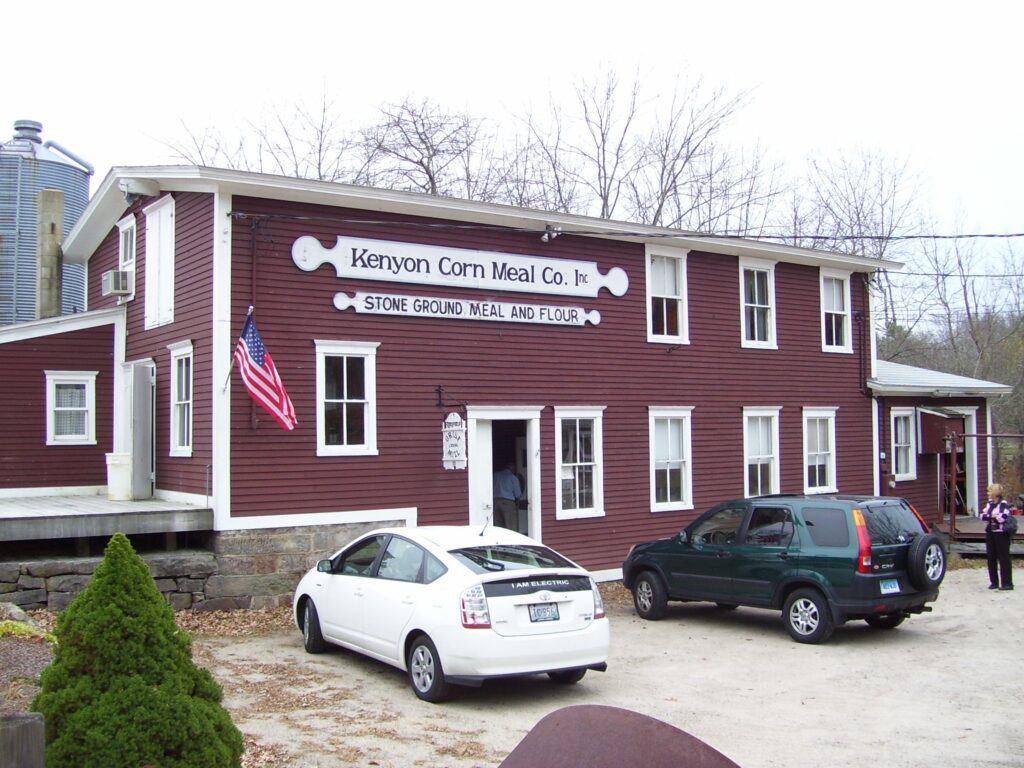
Early settlers adeptly incorporated cornmeal into a range of dishes, showcasing both practicality and regional tastes across the Americas. Cornbread, a simple yet hearty staple, exemplified this adaptation. Prepared by mixing cornmeal with water or milk, eggs, and sometimes sweeteners like molasses or honey, it was baked to perfection in hot ovens or on griddles. Southern variations leaned towards savory profiles with a tangy buttermilk twist, while Northern versions favored sweetness with added sugar or molasses.
Johnnycakes, also known as journey cakes or hoecakes, further demonstrated cornmeal’s versatility. These flatbreads, made from cornmeal and water, were cooked on griddles or skillets, serving as a reliable sustenance during arduous journeys or outdoor work.
Beyond bread, cornmeal found its way into comforting desserts like cornmeal pudding. Combining cornmeal with milk, eggs, sugar, and aromatic spices such as cinnamon or nutmeg, this pudding was either baked or steamed to achieve a warm, custard-like consistency that offered a satisfying conclusion to a meal.
The integration of cornmeal into American desserts not only underscored settlers’ resourcefulness in adapting to new ingredients but also fostered the evolution of a distinctive culinary landscape. Its widespread availability and adaptability contributed significantly to early American pastry techniques, leaving an indelible mark on the nation’s rich culinary heritage that continues to be cherished and celebrated today.
Cornmeal Pudding: This dish combined cornmeal with milk, eggs, and sweeteners like molasses or honey. It was baked until set and sometimes flavored with spices like cinnamon and nutmeg.
Apple Pie
Apple pie holds a special place in American culinary history, often celebrated as a symbol of American tradition and comfort. Despite its iconic status, apples themselves were not native to the Americas; they were introduced by European settlers who brought seeds and saplings from their homelands. The early European colonists recognized the potential for apple cultivation in the New World due to its suitable climate and soil conditions.
One of the earliest mentions of apple trees being planted in North America dates back to the early 17th century. The Pilgrims, upon landing at Plymouth Rock in 1620, are said to have planted orchards, including apple trees, as they sought to establish agricultural self-sufficiency in their new environment. These early plantings laid the foundation for the apple’s integration into American agriculture and culinary culture.
The popularity of apple pie grew rapidly among the early settlers, becoming a familiar dish on colonial tables by the 18th century. The first American apple pie recipes closely resembled those brought over from Europe, featuring a double crust pastry filled with sliced apples that were often seasoned with cinnamon, nutmeg, and sugar. These pies were baked in wood-fired ovens, a common method of baking during that era, which imparted a distinct flavor and texture to the pastry.
Over time, regional variations of apple pie emerged across the American colonies, influenced by local apple varieties and culinary customs. In New England, for example, tart apples like the Rhode Island Greening were favored for their ability to hold up well in baking. In the Southern colonies, sweeter varieties such as the Newtown Pippin were often used, reflecting regional taste preferences.
By the 19th century, apple pie had firmly established itself as a symbol of American identity, referenced in literature, art, and popular culture as a wholesome and patriotic dessert. It became associated with homey virtues and domesticity, reinforced by its inclusion in iconic American texts such as Mark Twain’s “The Adventures of Huckleberry Finn” and the expression “as American as apple pie.”
Today, apple pie continues to be cherished across the United States, with variations ranging from classic recipes to modern interpretations that incorporate innovative twists on fillings or crusts. Its enduring popularity underscores its role not only as a dessert but also as a cultural icon that symbolizes tradition, nostalgia, and the enduring spirit of American culinary heritage.
19th Century Developments
Technological Advances
During the 19th century, American baking underwent a transformative period marked by significant technological advancements that revolutionized pastry-making practices across the country. These innovations not only improved the quality and consistency of baked goods but also democratized access to baking on a larger scale.
Technological Advancements in 19th Century American Baking:
Introduction of Baking Powder: One of the most groundbreaking advancements in American baking was the introduction of baking powder in the mid-19th century. Baking powder provided a reliable and effective leavening agent, replacing the traditional methods of using yeast or beaten eggs. This innovation allowed bakers to produce lighter, fluffier, and more consistent baked goods, such as cakes, biscuits, and quick breads, with significantly less effort and time. The widespread adoption of baking powder revolutionized home baking and commercial bakery operations alike, setting a new standard for pastry texture and taste.
Development of Mechanical Mixers and Ovens: Alongside baking powder, the development of mechanical mixers and ovens during the 19th century streamlined the baking process and increased efficiency. Mechanical mixers replaced labor-intensive hand mixing, enabling bakers to achieve more uniform and thoroughly blended doughs. This innovation not only saved time but also improved the quality of baked goods by ensuring even distribution of ingredients.
Simultaneously, advancements in oven technology enhanced baking precision and consistency. Traditional hearth ovens were gradually replaced by more sophisticated models equipped with temperature controls and improved insulation. These new ovens allowed for more precise baking times and temperatures, resulting in more reliable outcomes and greater versatility in pastry production.
Impact on American Baking Practices: The combined impact of baking powder, mechanical mixers, and advanced ovens democratized baking in America. Home cooks could now achieve professional-quality results with greater ease, fostering a culture of baking experimentation and innovation. Commercial bakeries capitalized on these advancements to increase production capacities and diversify their product offerings, meeting growing consumer demand for a wider variety of pastries and baked goods.
Cultural Influence
During the 19th century, the United States experienced a significant influx of immigrants from various European countries, each bringing with them rich culinary traditions that left a lasting imprint on American pastry culture. This period marked a diverse infusion of flavors, techniques, and recipes that contributed to the vibrant tapestry of American baking.
Immigrant Contributions to American Pastry:
German Influence: German immigrants introduced several iconic pastries and baked goods to American cuisine. Among the most notable were strudels, which are thin layers of pastry wrapped around a sweet or savory filling, often containing fruits like apples or cherries. Pretzels, another German staple, made their way into American bakeries, known for their distinctive twisted shape and savory flavor.

Italian Influence: Italian immigrants brought with them a treasure trove of pastry delights. Biscotti, traditional Italian twice-baked cookies often flavored with almonds or other nuts, gained popularity among American consumers for their crunchy texture and versatility as a dunking cookie. Cannoli, another beloved Italian pastry, made its mark with its crisp fried shell filled with sweetened ricotta cheese and often adorned with chocolate chips or candied fruit.
Scandinavian Contributions: Scandinavian immigrants enriched American pastry culture with their own array of traditional treats. Krumkake, a Norwegian delicacy, became a favorite for its delicate, cone-shaped waffle cookie filled with whipped cream or other fillings. Cinnamon rolls, originally known as “kanelbullar” in Sweden, also became a cherished pastry in American households, loved for their tender dough and aromatic cinnamon filling topped with sweet icing.
Impact on American Baking: The introduction of these diverse pastry traditions not only expanded the palate of American consumers but also influenced local baking practices and preferences. Bakeries across the country began offering a wider selection of pastries, reflecting the cultural diversity of their communities and catering to the evolving tastes of their customers.
Regional Specialties
Regional specialties began to emerge, reflecting the local ingredients and cultural influences. The South became known for its pecan pie and sweet potato pie, while the Northeast popularized whoopie pies and Boston cream pie. These regional variations added to the rich diversity of American pastry.
Early 20th Century: The Golden Age of Baking
Commercial Baking
The early 20th century marked the rise of commercial bakeries and mass production of baked goods. Companies like Nabisco and Hostess introduced iconic American pastries such as Oreos and Twinkies, making baked goods widely accessible and popular.
Homemade Pastry Trends
During the early 20th century, home baking in the United States experienced a significant surge in popularity, largely influenced by the accessibility of cookbooks and the emergence of culinary icons who promoted baking as a household activity. This period marked a cultural shift where homemakers and aspiring cooks turned to printed recipes and guidance from culinary experts to master the art of baking.
Home Baking and the Rise of Cookbooks:
Accessibility of Recipes: Cookbooks became essential tools for home bakers, offering a wealth of recipes ranging from simple breads and cakes to elaborate pastries. These books provided detailed instructions, ingredient lists, and baking tips that empowered individuals to replicate professional-quality baked goods in their own kitchens. One of the most influential figures during this time was Betty Crocker, a fictional character created by General Mills, whose persona and recipes became synonymous with successful home baking.
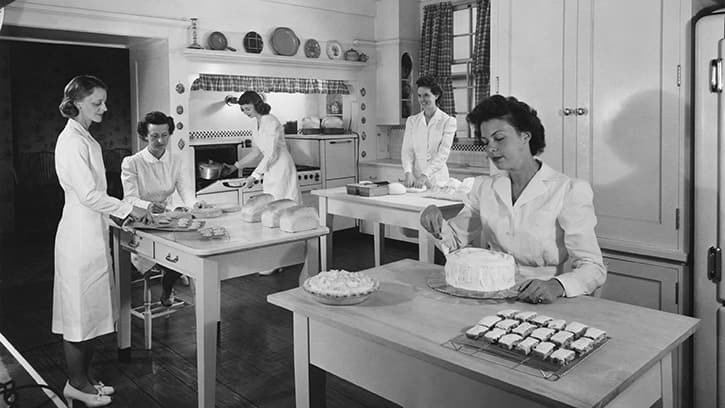
Culinary Icons and Influencers: Culinary icons such as Betty Crocker played a pivotal role in promoting baking as a domestic skill. Through radio programs, magazines, and later television shows, these figures not only shared recipes but also demystified baking techniques, encouraging individuals to experiment and develop their baking prowess. Their influence extended beyond the kitchen, shaping cultural norms and fostering a sense of community among home bakers.
Impact on American Baking Culture: The popularity of home baking during this era fostered a rich baking culture in America characterized by creativity, experimentation, and tradition. Families bonded over baking sessions, passing down recipes through generations and establishing cherished culinary legacies. This era also saw the development of baking competitions and community bake-offs, further solidifying baking as a beloved pastime and a way to showcase skill and creativity.
Post-War Innovations
Convenience Baking
The post-war era brought about the introduction of pre-packaged mixes and frozen pastries, making baking more convenient for busy households. Products like cake mixes and ready-to-bake doughs became staples in American kitchens, further popularizing home baking.
Influence of Television
Television played a significant role in shaping American baking habits. Cooking shows, particularly those featuring influential figures like Julia Child, introduced viewers to new techniques and recipes, inspiring a generation of home bakers.
In the modern era of American pastry, there has been a notable resurgence in artisanal techniques and a renewed appreciation for high-quality ingredients, marking a return to traditional baking methods. Artisanal bakeries and pastry shops have emerged as focal points for these practices, prioritizing craftsmanship and the use of locally sourced ingredients. This movement not only celebrates the artistry of baking but also emphasizes sustainability and supporting local communities through conscious sourcing practices.
Return to Artisanal Techniques: Artisanal baking in the United States has seen a revival driven by a desire for authenticity and superior taste. Bakers and pastry chefs are increasingly turning to age-old methods such as sourdough fermentation, hand-rolling croissants, and slow-proofing doughs to achieve exceptional flavor and texture. This approach contrasts with mass-produced baked goods, offering consumers a more personalized and flavorful experience that connects them to the origins of their food.
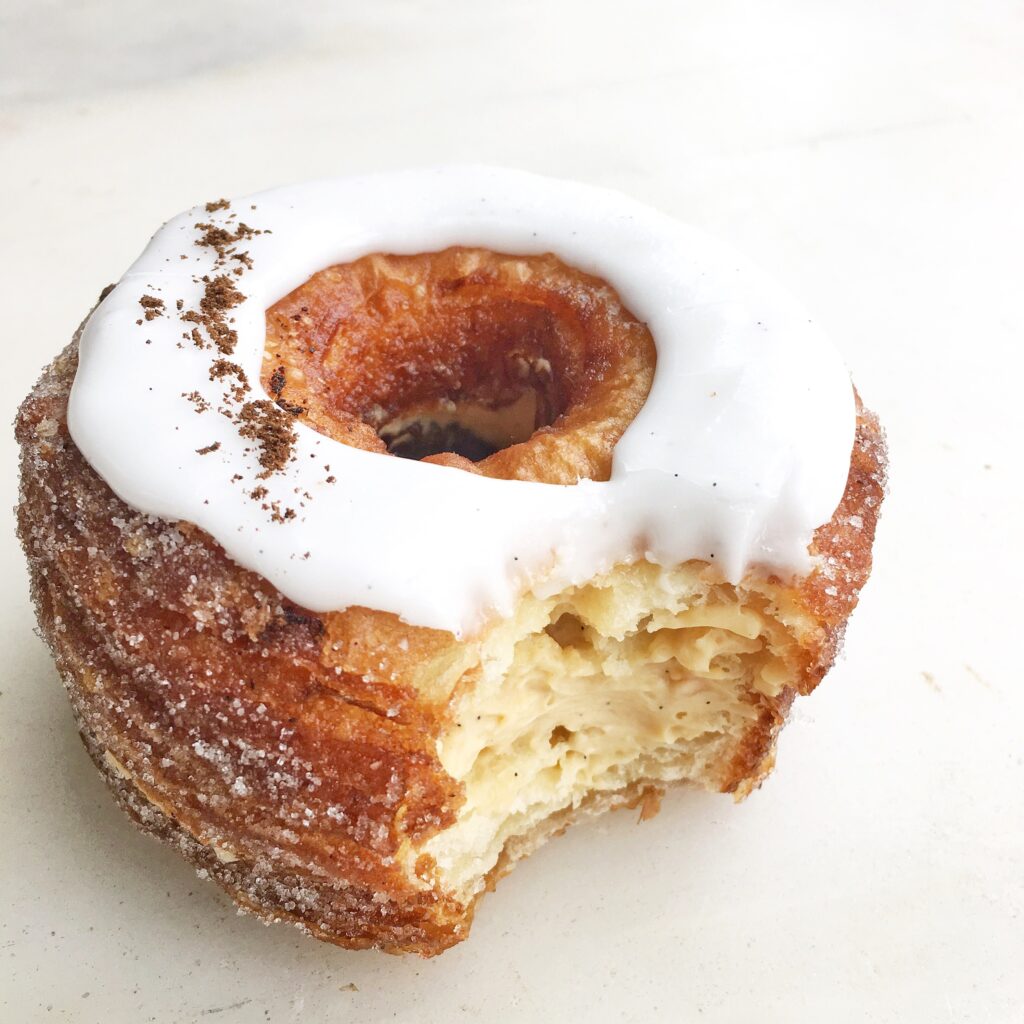
Fusion and Innovation: Modern American pastry is characterized by its dynamic fusion of international flavors and innovative techniques. Pastry chefs are pushing boundaries by integrating global culinary influences into traditional recipes, resulting in exciting creations that appeal to diverse palates. Iconic examples include the Cronut, a hybrid of croissant and doughnut, which sparked worldwide culinary excitement and inspired a wave of hybrid pastry innovations. Gourmet cupcakes have also evolved beyond simple flavors, with bakeries experimenting with exotic ingredients and creative presentations to redefine this classic treat.
Health Conscious Baking: In response to growing health awareness, American pastry techniques have adapted to accommodate dietary preferences and restrictions. There is a notable shift towards gluten-free, vegan, and allergen-friendly pastries, reflecting a broader commitment to wellness without compromising on taste or texture. Ingredients such as alternative flours, plant-based fats, and natural sweeteners are increasingly used to create indulgent treats that cater to diverse dietary needs while meeting high culinary standards.
Notable Pastry Chefs and Their Contributions
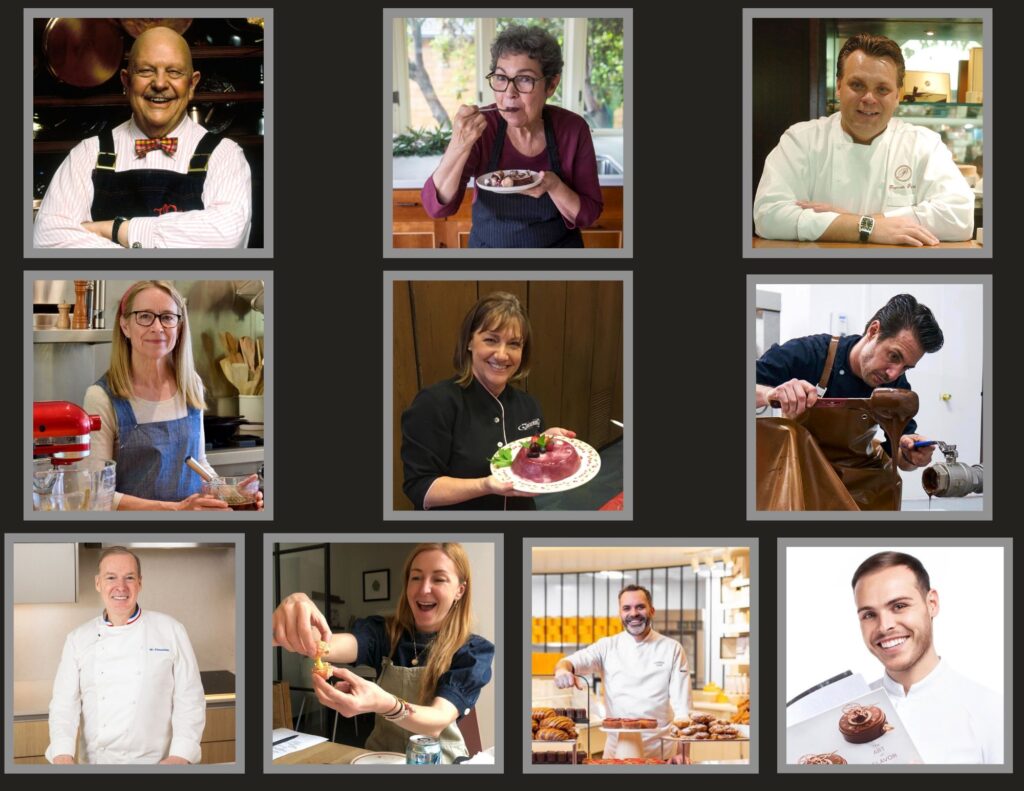
Although not a pastry chef, James Beard, is often regarded as the “Dean of American Cookery.” He played a pivotal role in advocating for and promoting American cuisine, including pastry techniques. Through his writing and teaching, Beard celebrated the diversity of American culinary traditions and emphasized the use of fresh, locally sourced ingredients. His seminal work, “American Cookery,” published in 1972, remains a cornerstone in the canon of American cooking literature. Beard’s advocacy helped establish a foundation for American pastry chefs to explore and innovate within their culinary heritage, inspiring generations of chefs to embrace quality ingredients and traditional methods.
Alice Medrich is acclaimed for her expertise in chocolate and dessert creations, earning recognition as a pioneer in the field of American pastry. Her contributions to the art of baking are underscored by her meticulous approach to chocolate desserts, where she combines classic techniques with innovative flavor combinations. Medrich’s influential books, such as “Bittersweet: Recipes and Tales from a Life in Chocolate,” have empowered home bakers and professional chefs alike to experiment with chocolate and explore its nuanced flavors. Beyond chocolate, Medrich’s advocacy for precision in baking techniques has elevated the standards of American pastry, emphasizing the importance of meticulous recipe development and thoughtful ingredient selection.
Emily Luchetti is celebrated for her expertise in pastry arts and desserts. As the executive pastry chef at San Francisco’s Farallon and Waterbar restaurants, she has been instrumental in shaping the dessert scene on the West Coast. Luchetti is known for her elegant and inventive approach to desserts, blending traditional techniques with innovative flavors and presentations. She has authored several acclaimed cookbooks, including “A Passion for Desserts,” which showcases her mastery of pastry and dessert recipes.
François Payard is a highly respected pastry chef and chocolatier known for his exceptional skill in creating exquisite pastries and chocolates. Hailing from a family of pastry chefs in France, Payard has brought his expertise to New York City, where he established François Payard Bakery and FP Patisserie. His signature desserts, such as the Flourless Chocolate Walnut Cookie and the Raspberry Pistachio Tart, have earned him numerous accolades. Payard’s dedication to precision and creativity has made him a prominent figure in the American pastry landscape.
Gale Gand is an award-winning pastry chef and restaurateur who has made significant contributions to American pastry through her innovative approach and culinary expertise. Known for her work at Tru restaurant in Chicago, Gand has inspired countless pastry enthusiasts with her creative desserts and dedication to seasonal ingredients. She has authored several cookbooks, including “Butter Sugar Flour Eggs,” which showcases her passion for baking and dessert making.
Johnny Iuzzini gained prominence as the executive pastry chef at Jean-Georges restaurant in New York City, where he earned critical acclaim for his inventive desserts. Iuzzini’s innovative approach to pastry incorporates modern techniques and a deep understanding of flavor profiles. He has been recognized with numerous awards, including the James Beard Award for Outstanding Pastry Chef. Iuzzini’s influence extends beyond the kitchen, as he has authored books and appeared on television shows, sharing his expertise and passion for pastry with a wider audience.
Jacques Torres, also known as “Mr. Chocolate,” is a master pastry chef and chocolatier renowned for his expertise in chocolate craftsmanship. Originally from France, Torres moved to the United States where he established himself as a leading figure in the chocolate industry. His artisanal chocolates and desserts have garnered widespread acclaim, and he has expanded his influence through chocolate shops, TV appearances, and educational initiatives.
Christina Tosi is a pastry chef, author, and founder of Milk Bar, a bakery known for its innovative approach to desserts. Tosi gained recognition for her playful and nostalgic desserts, such as the famous Milk Bar Pie and Compost Cookies. Her unique style blends traditional baking techniques with unconventional ingredients, appealing to a new generation of dessert enthusiasts. Tosi has been featured on television shows and has authored cookbooks that highlight her creative recipes and pastry innovations.
Dominique Ansel gained international fame for creating the Cronut, a croissant-doughnut hybrid that sparked a global pastry craze. As the owner of Dominique Ansel Bakery in New York City and other locations worldwide, Ansel continues to push the boundaries of pastry with inventive creations like the Frozen S’mores and Cookie Shot. His commitment to quality ingredients and meticulous craftsmanship has earned him numerous accolades and a dedicated following.
Amaury Guichon is a renowned pastry chef and chocolatier known for his extraordinary talent in creating intricate and visually stunning pastry and chocolate sculptures. Originally from France, Guichon has gained international acclaim for his artistic approach to pastry, blending meticulous craftsmanship with innovative techniques. He worked at a number of pastry kitchens in Las Vegas including the Aria Resort and Casino and Bellagio. He also worked as a private consultant and conducted masterclasses. In 2019, Guichon co-found the Pastry Academy with Belgian chef Michel Ernots in Las Vegas.
In 2016, Guichon began posting his desserts and chocolate creations on social media. He has over 16.5 million subscribers on YouTube, 15.5 million followers on Instagram and 24 million followers on TikTok
Guichon’s debut dessert cooking book The Art of Flavor was published on 13 December 2018
Regional Pastry Traditions
Northeast
The Northeast is renowned for its iconic pastries such as Boston cream pie, apple pie, and whoopie pies, which embody the region’s rich history and culinary traditions. These treats highlight the use of local ingredients and time-honored techniques.
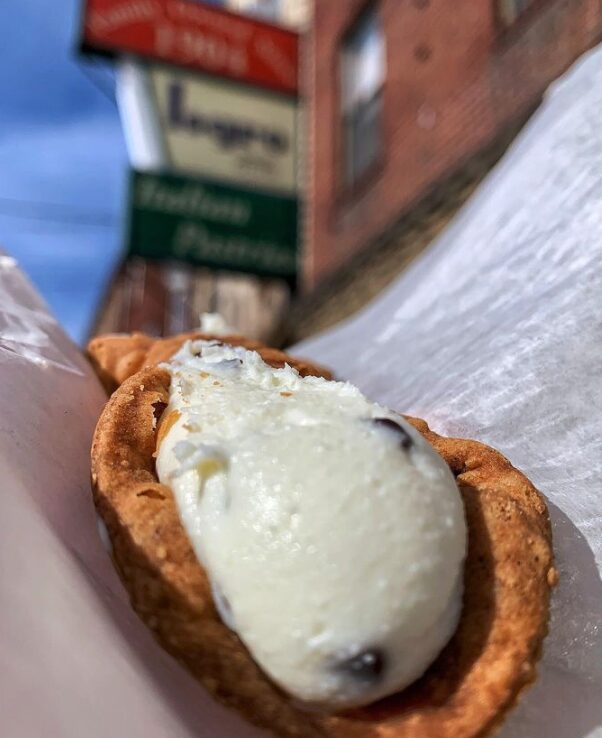
Moreover, due to the sizable Italian population along the Northeast Corridor, including cities like Boston, New York, Philadelphia, Pittsburgh, and parts of New Jersey, a variety of Italian desserts have gained widespread popularity. These include Italian cookies, cannolis (especially from renowned bakeries like Termini Bros. Bakery and Isgro Bakery in Philadelphia), pizzelles, sfogliatelle, and Italian rum cream cakes.
South
Southern pastries like pecan pie, sweet potato pie, and beignets are integral to the culinary tapestry of the region, reflecting its diverse cultural influences and longstanding culinary traditions.
Pecan Pie: Pecan pie is a quintessential Southern dessert known for its rich, gooey filling made from pecans, corn syrup, sugar, and eggs, all baked in a flaky crust. The pecan tree is native to the southern United States, particularly in states like Georgia and Texas, making pecans readily available and a staple ingredient in Southern baking (Southern Living, n.d.).
Sweet Potato Pie: Sweet potato pie is another beloved Southern dessert, often enjoyed during holidays like Thanksgiving. It originated from African culinary traditions brought to America by enslaved Africans. Sweet potatoes were abundant in the South and became a popular substitute for pumpkin in pies (Southern Living, n.d.).
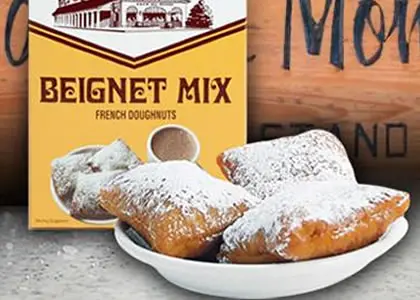
Beignets: Beignets are a French-inspired pastry that found a home in the culinary landscape of New Orleans and the broader Southern region. These deep-fried pastries are dusted with powdered sugar and typically served hot and fresh. They have become synonymous with New Orleans culture and are enjoyed as a breakfast treat or a delightful dessert (History.com Editors, 2009).
These Southern pastries not only showcase the region’s agricultural abundance but also reflect the cultural diversity that has shaped Southern cuisine over centuries. Their popularity endures as they continue to be cherished symbols of Southern hospitality and culinary heritage.
Midwest
The Midwest region of the United States is celebrated for its rich tapestry of pastries influenced by a diverse array of immigrant populations. These pastries, including kolaches, kringles, and buckeyes, highlight the unique cultural amalgamation and local adaptations that define the Midwest’s culinary identity.
Kolaches: Originating from Czech immigrants who settled predominantly in states like Nebraska, Iowa, and Texas, kolaches are soft, pillowy pastries filled with sweet fillings such as fruit preserves, cheese, or poppy seeds. They are often enjoyed as a breakfast pastry or a snack throughout the day, reflecting the Czech tradition of sweet pastries (Texas Czech Heritage & Cultural Center, n.d.).
Kringles: Introduced by Danish immigrants who settled in Wisconsin, kringles are oval-shaped, flaky pastries filled with fruit, nuts, or other sweet fillings. They are often topped with icing or sugar glaze and have become a beloved symbol of Danish-American heritage in the Midwest, particularly in communities like Racine, Wisconsin (Discover Wisconsin, n.d.).

Buckeyes: Originating from Ohio, buckeyes are named after the state tree, the buckeye tree. These confectionery treats are made from a creamy peanut butter filling dipped in chocolate, resembling the nuts of the buckeye tree. Buckeyes have become a popular homemade treat across the Midwest, especially during holidays and sporting events (Ohio History Central, n.d.).
These Midwest pastries not only showcase the region’s cultural diversity but also demonstrate how immigrant traditions have shaped the local culinary landscape. They continue to be cherished by residents and visitors alike for their unique flavors and historical significance.
West Coast
The West Coast of the United States is renowned for its vibrant and diverse culinary landscape, particularly in the realm of pastries. From California to the Pacific Northwest, the region’s innovative spirit and emphasis on fresh, high-quality ingredients have shaped its distinctive pastry traditions.
California Fruit Pastries: Reflecting the state’s abundant agricultural resources, California fruit pastries showcase a variety of locally grown fruits incorporated into pastries such as pies, tarts, and turnovers. These pastries highlight the freshness and seasonal diversity of California’s produce, appealing to both locals and visitors seeking a taste of the region’s natural bounty (California Grown, n.d.).
Artisanal Bread: The West Coast has embraced the artisanal bread movement, characterized by small-scale bakeries that prioritize traditional baking methods and premium ingredients. Sourdough bread, in particular, has become synonymous with San Francisco, where the cool climate and unique yeast strains contribute to its distinctive tangy flavor and chewy texture (Smithsonian Magazine, 2013).
Fusion Desserts: The West Coast’s culinary melting pot has spurred the creation of fusion desserts that blend diverse cultural influences and techniques. Examples include the Cronut (croissant-doughnut hybrid) pioneered in New York but embraced and adapted on the West Coast, as well as gourmet cupcakes featuring inventive flavor combinations and artistic decorations (Los Angeles Times, 2013).
These pastries not only showcase the region’s creativity and commitment to culinary excellence but also celebrate its rich agricultural heritage and cultural diversity.
Challenges and Future Trends
Sustainability
Sustainability is a growing concern in pastry production. Innovations in sustainable ingredients and packaging are becoming increasingly important, reflecting a broader commitment to environmental stewardship in the culinary industry.
Technological Advancements
Technological advancements are profoundly influencing the evolution of American pastry techniques, pushing boundaries and opening new possibilities in culinary innovation.
3D Printing: In recent years, 3D printing has emerged as a revolutionary tool in pastry making. It allows chefs to create intricate designs and shapes that would be difficult or impossible to achieve by hand. From customized chocolate sculptures to delicate sugar decorations, 3D printing enables pastry chefs to unleash their creativity and offer unique culinary experiences (Forbes, 2018).
Molecular Gastronomy: Molecular gastronomy involves applying scientific principles and techniques to manipulate ingredients and transform textures in cooking. In pastry, this approach allows for innovative desserts that play with textures, temperatures, and flavors in unexpected ways. Techniques like spherification, foams, and gels enable chefs to create desserts that surprise and delight both visually and gastronomically (Eater, 2020).
Artificial Intelligence (AI): AI is increasingly being integrated into pastry making to streamline processes and enhance precision. AI-powered systems can analyze vast amounts of data to optimize recipes, predict consumer trends, and even assist in recipe development. For instance, AI can recommend flavor combinations based on sensory data or assist in maintaining consistent quality in large-scale production (Food Business News, 2020).
These technologies represent the forefront of culinary innovation, blending creativity with scientific rigor to push the boundaries of what is possible in pastry artistry.
The history of American pastry techniques is a rich and diverse narrative, reflecting the blend of tradition and innovation that defines American cuisine. From colonial beginnings to modern fusion trends, American pastry has continuously evolved, incorporating a wide range of influences and adapting to new challenges. As the culinary world continues to innovate, the future of American pastry looks bright, promising even more exciting developments in the years to come.
References
- Smith, Andrew F. “The Oxford Companion to American Food and Drink”. Oxford University Press, 2007.
- Gabaccia, Donna R. “We Are What We Eat: Ethnic Food and the Making of Americans”. Harvard University Press, 1998.
- Marks, Gil. “Encyclopedia of Jewish Food”. John Wiley & Sons, 2010.
- Shapiro, Laura. “Perfection Salad: Women and Cooking at the Turn of the Century”. University of California Press, 2008.
- Child, Julia. “Mastering the Art of French Cooking”. Alfred A. Knopf, 1961.
- Anastopoulo, Rossi. “Sweet Land of Liberty – A History of America in 11 Pies.” Abrams Press, 2022.
- Forbes. (2018). How 3D printing is revolutionizing the food industry. Retrieved from https://www.forbes.com/sites/bernardmarr/2018/08/20/how-3d-printing-is-revolutionizing-the-food-industry/#5b84952c5d50
- Eater. (2020). The basics of molecular gastronomy and modernist cuisine. Retrieved from https://www.eater.com/2012/5/17/6582097/the-basics-of-molecular-gastronomy-and-modernist-cuisine
- Food Business News. (2020). The role of AI in the future of food. Retrieved from https://www.foodbusinessnews.net/articles/17614-the-role-of-ai-in-the-future-of-food
- California Grown. (n.d.). California Grown – Fruit. Retrieved from https://californiagrown.org/fruit
- Los Angeles Times. (2013). Cupcakes rise to new heights in L.A. Retrieved from https://www.latimes.com/food/la-xpm-2013-jan-17-la-fo-cupcakes-20130119-story.html
- Smithsonian Magazine. (2013). The history of sourdough. Retrieved from https://www.smithsonianmag.com/history/the-history-of-sourdough-its-not-french-its-not-san-franciscan-its-earlier-180947743/
- Discover Wisconsin. (n.d.). Kringle – A Taste of Wisconsin’s Danish Heritage. Retrieved from https://www.discoverwisconsin.com/travel-wisconsin/kringle-a-taste-of-wisconsins-danish-heritage/
- Ohio History Central. (n.d.). Buckeye (Candy). Retrieved from https://ohiohistorycentral.org/w/Buckeye_(candy)
- Texas Czech Heritage & Cultural Center. (n.d.). Czech Kolaches – The Texas Heritage Society. Retrieved from https://www.czechtexas.org/kolaches
- History.com Editors. (2009). Beignets: The History of New Orleans’ Favorite Pastry. Retrieved from https://www.history.com/news/beignets-history-new-orleans-pastrySouthern Living. (n.d.).
- The Secret History of Pecan Pie. Retrieved from https://www.southernliving.com/food/how-to/pecan-pie-history
- “American Cookery.” Beard, James, Little, Brown and Company, 1972.
- “Recipes and Tales from a Life in Chocolate.” Medrich, Alice, Artisan, 2003.
- “The Great Book of Chocolate.” Lebovitz, David, Ten Speed Press, 2004.
- “The Fearless Baker: Simple Secrets for Baking Like a Pro.” Emily Luchetti and Lisa Weiss, Little, Brown and Company, 2017.
- “The Wholesome Kitchen: Nourish. Energize. Indulge.” Pooja Dhingra, HarperCollins India, 2020.
- “Nancy Silverton’s Breads from the La Brea Bakery: Recipes for the Connoisseur” Nancy Silverton and Teri Gelber, Villard, 1996.
- “Eight Flavors: The Untold Story of American Cuisine.” Sarah Lohman, Simon & Schuster, 2016.
- “The Oxford Companion to American Food and Drink.” Andrew F. Smith, Oxford University Press, 2007.
- “American Cake: From Colonial Gingerbread to Classic Layer, the Stories and Recipes Behind More Than 125 of Our Best-Loved Cakes.” Anne Byrn, Rodale Books, 2016.
- “The Encyclopedia of American Food and Drink.” John F. Mariani, Bloomsbury Publishing, 2014.
- Sarah Lohman, Simon & Schuster, 2016.
- “America Eats: Forms of Edible Folk Art.” William Woys Weaver, Harper & Row, 1989.
- “Food in Colonial and Federal America.” Sandra L. Oliver, Greenwood Press, 2005.
- “The Island at the Center of the World: The Epic Story of Dutch Manhattan and the Forgotten Colony That Shaped America.” Russell Shorto, Vintage Books, 2005.
- “The Sensible Cook: Dutch Foodways in the Old and the New World.” Peter G. Rose, Syracuse University Press, 1998.
- “The Oxford Companion to Sugar and Sweets” edited by Darra Goldstein, Oxford University Press, 2015.
- “The Food of the Netherlands: Authentic Recipes from the Heart of Europe” by Annette Wolter, Skyhorse Publishing, 2018.
- “The Dutch Table: Gastronomy in the Golden Age of the Netherlands” by M. Welcker, J. Pennings, and P. H. Walgreen, 2004.
- “The Art of French Pastry” by Jacquy Pfeiffer and Martha Rose Shulman, Knopf, 2013.”The Food of France” by Waverley Root, Vintage Books, 1992.
- Food in Early Modern Europe. Ken Albala, Greenwood Press, 2003.
- American Cookery by Amelia Simmons, 1796.
- “Pumpkin: The Curious History of an American Icon.” Cindy Ott, University of Washington Press, 2013.
- “American Cookery.” Amelia Simmons, Hudson & Goodwin, 1796
- “The Oxford Companion to American Food and Drink.” Andrew F. Smith, Oxford University Press, 2007.
- A History of American Pastry. The Culinary Institute of America.
- “Food in Colonial and Federal America.” Sandra Oliver, Greenwood, 2005.